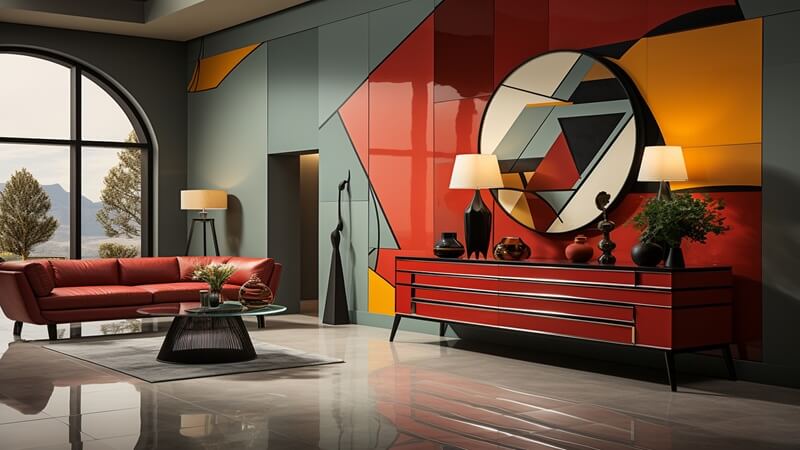In recent years, homes have become more than just places to live—they’ve evolved into spaces of comfort, personality, and well-being. By 2025, interior design trends will emphasize individuality, soulful aesthetics, and a deep connection with nature and wellness. Instead of following rigid rules, homeowners and designers are embracing layered spaces, bolder palettes, sustainable choices, and innovative layouts that reflect both lifestyle and creativity.
This guide explores every aspect of modern interiors, from colors and materials to furniture, textures, and functional designs. With proper guidance and detailed explanations, you’ll discover how to apply these evolving ideas in your own spaces, whether you love minimalism, maximalism, or something in between.
1. The Evolution of Interior Design
From Rules to Personalization
Design in earlier decades followed strict formulas—neutral walls, matching sets, and polished finishes. But the latest movement values expression over uniformity. Personalization drives modern interiors, where no two homes need to look alike.
Influence of Global Living
Travel, digital inspiration, and cultural exchange have influenced today’s interiors. Moroccan tiles, Scandinavian simplicity, and Japanese minimalism often merge seamlessly in one space, reflecting a globalized approach to aesthetics.
2. Color Trends Shaping 2025
Warm and Earthy Palettes
Designers are replacing stark whites and cool grays with rich tones: terracotta, ochre, muted sage, and olive green. These shades create depth and warmth, offering a grounded atmosphere.
Oxblood Red and Jewel Tones
Oxblood—a deep red with brown undertones—adds drama to interiors. Alongside jewel tones like emerald, sapphire, and amethyst, it brings sophistication and vibrancy to both modern and classic spaces.
Moody Blues and Purples
Deep blues, plums, and purples turn bedrooms and lounges into sanctuary-like retreats. When paired with warm metals, these colors evoke intimacy and luxury.
Softer Neutrals
Instead of cold minimalism, designers prefer beige, soft taupe, and greige. These hues balance bold accents without overwhelming a space.
3. Textures and Materials
Organic Textures
Wood, stone, rattan, and linen are popular for adding natural warmth. Woven textiles, raw ceramics, and imperfect finishes celebrate authenticity over perfection.
Mixed Metals
While brass dominated the last decade, stainless steel, nickel, and chrome are regaining popularity. Mixing metals—such as blackened steel with brushed gold—creates layered, eclectic details.
Porcelain Countertops
Heat- and stain-resistant porcelain has risen as a sustainable alternative to quartz. Its durability and lower silica content make it a smart choice for kitchens.
Layered Surfaces
Bouclé, grasscloth wallpaper, limewash walls, and textured plasters bring visual dimension. Layering tactile materials makes rooms cozy and interesting.
4. Furniture and Forms
Curved and Organic Shapes
Furniture design is embracing soft curves. Sofas with rounded arms, circular dining tables, and arched bookshelves add flow and comfort.
Oversized Sofas and Pit Seating
Generous modular sofas designed for lounging encourage relaxed, communal living. “Pit seating” setups—low and wide—are making a big comeback.
Vintage and Heirloom Pieces
Thrifted or inherited furniture adds character and sustainability. Incorporating a mid-century sideboard or antique chair alongside modern pieces balances nostalgia with relevance.
Low-Slung Furniture
Inspired by the 1970s, low-profile furniture sits closer to the ground, creating informal and inviting spaces.
5. Key Decorating Techniques
Color and Pattern Drenching
Walls, ceilings, and trims painted in one bold color create immersive environments. Pattern drenching expands the idea—extending wallpaper and fabric motifs across entire rooms.
Statement Ceilings
Often called the “fifth wall,” ceilings now receive design attention. Bold paint, beams, or patterned wallpaper turn them into show-stopping features.
Wallpaper Revival
Wallpaper’s comeback includes everything from oversized florals to geometric prints. Designers also apply wallpaper to ceilings and cabinetry for a surprise element.
Dramatic Countertops and Backsplashes
Waterfall countertops, bookmatched stone, and artisan tiles transform kitchens into artistic statements.
6. Lighting as Atmosphere
Delicate Fixtures
Glass globes, handmade ceramic pendants, and minimal sconces add subtle charm.
Layered Lighting
Combining ambient, task, and accent lighting ensures flexibility—from bright cooking spaces to dimmed, cozy evenings.
Natural Light Integration
Floor-to-ceiling windows, skylights, and glass walls blur the boundaries between indoors and outdoors.
7. Functional and Wellness Spaces
Spa-Like Bathrooms
Steam showers, freestanding tubs, and chromotherapy lighting redefine bathrooms as wellness retreats.
Hidden Features
Concealed storage, panel-ready appliances, and secret nooks keep spaces sleek and clutter-free.
Home Wellness Rooms
Yoga spaces, meditation corners, and in-home gyms highlight a lifestyle centered on balance and health.
Extended Kitchens and Outdoor Living
Kitchens expand into living rooms and patios, with outdoor cooking and dining becoming staples of modern homes.
8. Styles in Focus
Minimalist Calm
A clutter-free approach with neutral palettes, simple lines, and purposeful decor.
Maximalist Expression
Bold colors, eclectic patterns, and layered art bring vibrancy and personality.
Biophilic Design
Plants, water features, and natural light connect inhabitants to nature, promoting calmness and focus.
Art Deco Revival
Glamorous geometric patterns, bold colors, and luxurious materials add drama reminiscent of the 1920s.
Rustic Comfort
Exposed beams, raw wood, and earthy finishes create coziness and authenticity.
Mid-Century Modern
Clean lines, walnut woods, and retro-inspired forms remain timeless in modern homes.
9. Spaces That Speak Personality
Cozy Reading Nooks
Alcoves with shelves, soft lighting, and plush seating give homes soul.
Hidden Corners and Multipurpose Spaces
Small spaces become useful through clever design—foldaway desks, sliding doors, and hidden bars maximize potential.
Casual Comfort
“Fast furniture” may trend for quick solutions, but timeless investments in quality ensure sustainability.
10. Sustainable and Future-Forward Design
Reuse and Recycle
Designers encourage reupholstering, refurbishing, and reimagining old furniture rather than discarding.
Smart Homes
Technology integrates seamlessly with design—smart thermostats, voice-activated lighting, and energy-saving appliances are standard.
Eco Materials
Cork flooring, bamboo panels, and recycled glass countertops support sustainable living.
Conclusion
By 2025, interior design trends will reflect a clear departure from impersonal spaces. The emphasis lies in curating homes that feel authentic, sustainable, and deeply personal. With rich colors, layered textures, curved furniture, and wellness-focused layouts, modern interiors invite comfort and creativity. Whether you embrace maximalist flair, minimalist serenity, or a biophilic sanctuary, today’s design approaches encourage you to build spaces that inspire and restore.
For more info visit Stylishhome

